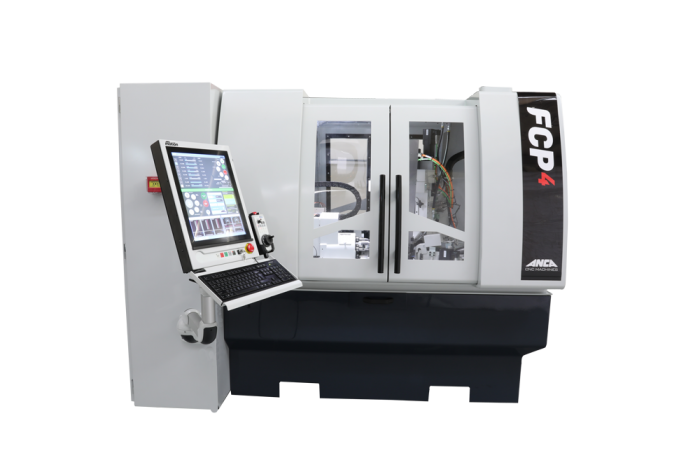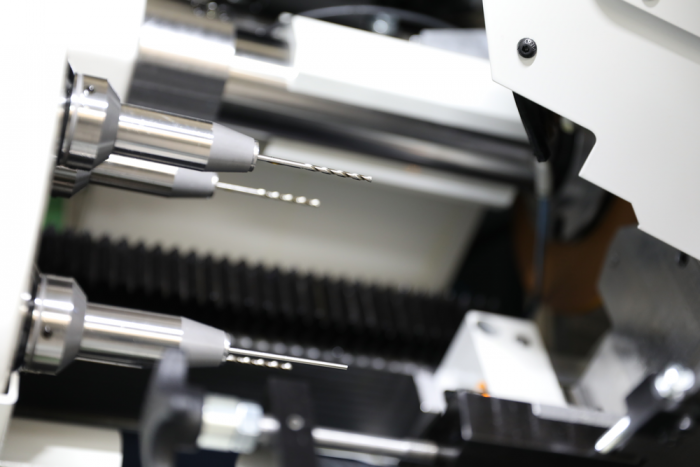Not every holemaking job requires a high-performance, solid-carbide or PCD-tipped drill with an advanced coating. For many, a HSS jobber drill will suffice.
How many? According to Grant Anderson, CEO of Melbourne, Australia-based grinding machine builder ANCA, toolmakers around the globe annually produce about 1.8 billion jobber drills. Generally, these commodity drills, which are typically used by tradespeople, handymen and do-it-yourselfers, are produced on two or three separate hydraulic- or cam-operated grinders, he added.
“They are oily and greasy machines, inflexible with their setup, take a long time to set up, and their product quality and productivity is quite poor relative to today’s technology,” Anderson said.

ANCA's FCP4 high-production drill grinder produces a complete drill in 20 to 25 seconds. Photos courtesy of ANCA
To provide a modern alternative, ANCA has introduced the FCP4 high-production drill grinder for producing a finished drill from 0.8mm to 4mm (0.031" to 0.157") in diameter. Anderson explained that the 8-axis CNC grinder has a turret that can simultaneously perform up to three operations for grinding the flute, relief and drill point and loading, and four collets to hold the drill.
The FCP4 CNC grinder will enable a complete drill to be manufactured every 20 to 25 seconds, a significant difference from what is currently available in the market, the company reports. The quick setup will also save significant time, going from possibly several hours on the old equipment to 20 minutes, Anderson added. “Our customers look to produce smaller batches and to be able to be more flexible to meet customer demand rather than run large batches and having to hold inventory.”

Toolmakers annually produce about 1.8 billion jobber drills.
Because the market for jobber drills is so price-sensitive and cam-operated machines are “people hungry,” requiring a lot of workers to run them, the centers of production are in low-labor-cost countries, Anderson said. However, those developing countries, such as China, are seeing labor costs rise and are automating more of their production. ANCA understands this and designs its grinders so they can operate unattended, he noted.
In addition, while the old technology has endured, it doesn’t last forever even after becoming obsolete. “With older machines wearing out and spare parts becoming scarce, there are currently very few options for upgrading or improving their capabilities,” Anderson said.
ANCA installed its first FCP4 grinder at the company’s demonstration facility in Shanghai and is currently producing its second one for demonstration and exhibition purposes in the U.S. “Absolutely, it will be at Grindtec and IMTS,” Anderson said.
Related Glossary Terms
- centers
centers
Cone-shaped pins that support a workpiece by one or two ends during machining. The centers fit into holes drilled in the workpiece ends. Centers that turn with the workpiece are called “live” centers; those that do not are called “dead” centers.
- computer numerical control ( CNC)
computer numerical control ( CNC)
Microprocessor-based controller dedicated to a machine tool that permits the creation or modification of parts. Programmed numerical control activates the machine’s servos and spindle drives and controls the various machining operations. See DNC, direct numerical control; NC, numerical control.
- grinding
grinding
Machining operation in which material is removed from the workpiece by a powered abrasive wheel, stone, belt, paste, sheet, compound, slurry, etc. Takes various forms: surface grinding (creates flat and/or squared surfaces); cylindrical grinding (for external cylindrical and tapered shapes, fillets, undercuts, etc.); centerless grinding; chamfering; thread and form grinding; tool and cutter grinding; offhand grinding; lapping and polishing (grinding with extremely fine grits to create ultrasmooth surfaces); honing; and disc grinding.
- grinding machine
grinding machine
Powers a grinding wheel or other abrasive tool for the purpose of removing metal and finishing workpieces to close tolerances. Provides smooth, square, parallel and accurate workpiece surfaces. When ultrasmooth surfaces and finishes on the order of microns are required, lapping and honing machines (precision grinders that run abrasives with extremely fine, uniform grits) are used. In its “finishing” role, the grinder is perhaps the most widely used machine tool. Various styles are available: bench and pedestal grinders for sharpening lathe bits and drills; surface grinders for producing square, parallel, smooth and accurate parts; cylindrical and centerless grinders; center-hole grinders; form grinders; facemill and endmill grinders; gear-cutting grinders; jig grinders; abrasive belt (backstand, swing-frame, belt-roll) grinders; tool and cutter grinders for sharpening and resharpening cutting tools; carbide grinders; hand-held die grinders; and abrasive cutoff saws.
- high-speed steels ( HSS)
high-speed steels ( HSS)
Available in two major types: tungsten high-speed steels (designated by letter T having tungsten as the principal alloying element) and molybdenum high-speed steels (designated by letter M having molybdenum as the principal alloying element). The type T high-speed steels containing cobalt have higher wear resistance and greater red (hot) hardness, withstanding cutting temperature up to 1,100º F (590º C). The type T steels are used to fabricate metalcutting tools (milling cutters, drills, reamers and taps), woodworking tools, various types of punches and dies, ball and roller bearings. The type M steels are used for cutting tools and various types of dies.
- relief
relief
Space provided behind the cutting edges to prevent rubbing. Sometimes called primary relief. Secondary relief provides additional space behind primary relief. Relief on end teeth is axial relief; relief on side teeth is peripheral relief.

